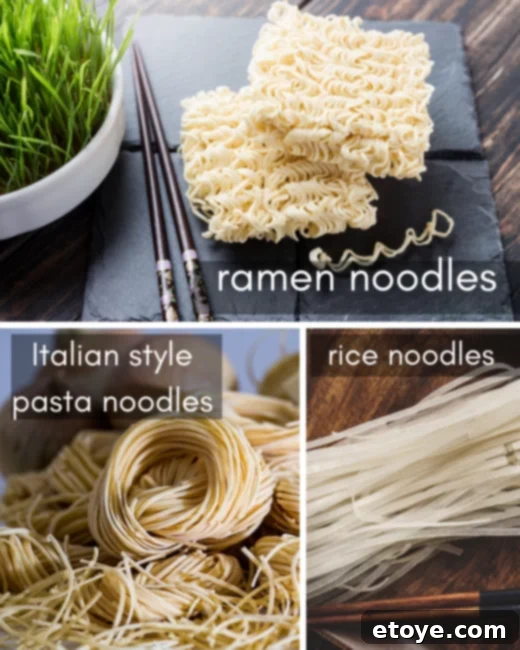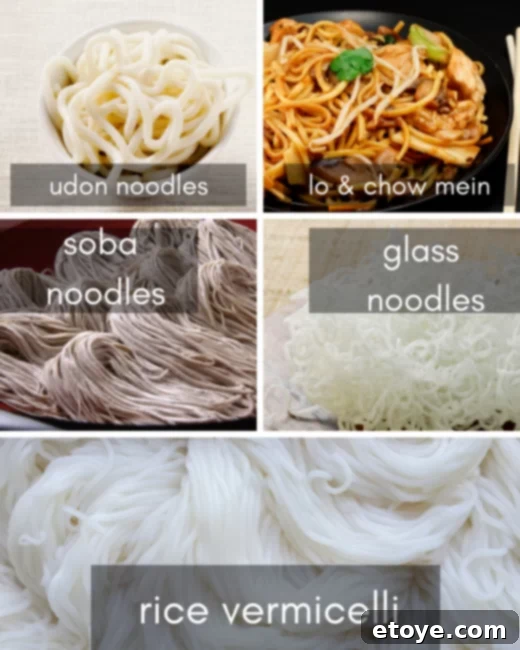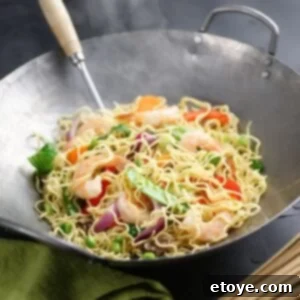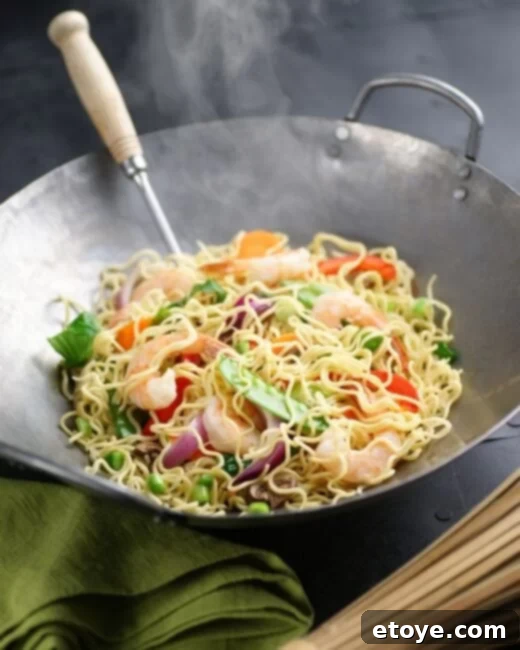Welcome to the ultimate guide for crafting a delectable Shrimp Chow Mein right in your own kitchen! This recipe is a revelation for anyone seeking a quick, easy, and incredibly satisfying meal that rivals your favorite takeout. More than just a dish, it’s an experience – a vibrant medley of tender noodles, perfectly seared shrimp, and crisp vegetables, all coated in a rich, savory stir-fry sauce that will have your taste buds singing. Forget the long waits and mystery ingredients; homemade Chow Mein offers unparalleled freshness, customizable flavors, and the undeniable satisfaction of creating culinary magic with minimal effort. Whether you’re a seasoned chef or a kitchen novice, this recipe is designed to be straightforward, ensuring a delicious outcome every single time.
What truly sets this Shrimp Chow Mein apart is its remarkable versatility. It’s not just a recipe; it’s a template for culinary creativity. You can effortlessly switch out the protein, experiment with a wide array of vegetables, and even adapt it to utilize those “odds and ends” lingering in your refrigerator. This flexibility makes it a perfect solution for weeknight dinners, allowing you to whip up a fresh and exciting meal tailored to your preferences or whatever ingredients you have on hand. While the possibilities for customization are vast, there’s one element we strongly recommend keeping consistent: our signature stir-fry sauce. This perfectly balanced blend of flavors is the secret weapon, guaranteeing that irresistible umami depth that defines truly great Chow Mein.

Why This Shrimp Chow Mein Recipe Will Become Your Go-To
Our Shrimp Chow Mein recipe isn’t just easy; it’s engineered for success, delivering maximum flavor and perfect textures with minimal fuss. Here’s why it consistently yields outstanding results:
- Perfectly Seared Shrimp, Every Time: A cornerstone of excellent stir-frying is ensuring each ingredient is cooked to perfection. Our technique involves searing the shrimp separately and quickly before adding it back into the wok. This prevents the shrimp from becoming tough or mushy due to overcooking, a common pitfall in many stir-fry recipes. Instead, you’ll enjoy succulent, tender shrimp with a delightful sear, maintaining their delicate flavor and texture. This isolated cooking method is crucial for achieving that professional stir-fry quality right at home.
- Unleash Your Culinary Creativity with Flexible Ingredients: This recipe is a true kitchen hero, designed to be incredibly adaptable. It’s the ideal “fridge-cleaning” meal, encouraging you to use up any vegetables that are nearing their prime. While we provide a base recipe with classic Chow Mein vegetables, feel free to substitute or add anything you have on hand. Think crisp bell peppers, crunchy snow peas, earthy mushrooms, tender bok choy, or vibrant broccoli florets. Similarly, if shrimp isn’t your preference, this recipe easily accommodates chicken, beef, pork, or even tofu. This flexibility not only minimizes food waste but also allows for endless variations, ensuring your Chow Mein is always fresh and exciting.
- The Secret Weapon: Our Perfectly Balanced Stir-Fry Sauce: The heart and soul of any great Chow Mein lies in its sauce, and ours is truly exceptional. We’ve meticulously crafted a blend that strikes a harmonious balance of salty, sweet, tangy, and savory notes, with the option to add a touch of spice if you desire. This versatile sauce is so delicious and foolproof that it can elevate any stir-fry dish, not just this Chow Mein. We highly recommend making a larger batch and storing it in your refrigerator; it’s a game-changer for quick, flavorful meals on demand.
While this recipe specifically calls for traditional Chow Mein noodles, don’t feel limited! The beauty of this dish is its adaptability. You can use any type of long noodle you prefer, and yes, that even includes Italian-style pastas! The key to success, regardless of your noodle choice, is to cook them just until ‘al dente’ – a delightful term referring to noodles that are firm to the bite, not soft or mushy. This ensures they hold up beautifully in the stir-fry and absorb all the incredible flavors of the sauce. As long as they’re “slurp-a-licious” (a highly technical and utterly essential term in our culinary lexicon!), you’re on the right track.

A Deep Dive into Noodles: From Asian Classics to Italian Adaptations
Noodles are the backbone of Chow Mein, and understanding their diversity can elevate your dish. Asian noodles boast a rich variety, crafted from different flours like white flour, rice flour, and whole wheat flour. Our beloved Chow Mein noodles, for instance, are typically made from wheat flour, giving them a distinct chewiness and ability to absorb sauce beautifully. While their compositions vary, a common thread among most Asian noodles is their long, slender shape – a symbol of longevity in many cultures.
Beyond Chow Mein noodles, the Asian culinary landscape offers a plethora of options. Lo Mein noodles are often thicker and chewier, typically tossed with sauce rather than stir-fried. Yakisoba noodles, a popular Japanese wheat noodle, offer a similar texture to Chow Mein and make an excellent substitute. Then there are delicate rice noodles, like vermicelli or wider flat rice noodles, which are staples in dishes like Pad Thai and various soups. Each type brings its unique texture and character to a dish, influencing how it interacts with the sauce and other ingredients.
Interestingly, while Asian noodles are primarily distinguished by their flour type, Italian pasta, though often made from similar wheat-based ingredients, shines in its vast array of shapes. These shapes aren’t just for aesthetics; they are meticulously designed to complement different sauces, from thin strands like spaghetti for light oil-based sauces to wider ribbons like fettuccine for creamy concoctions. This commonality in base ingredients means that in a pinch, or for a fun twist, certain Italian pastas like spaghetti or linguine can surprisingly stand in for Chow Mein noodles, provided they are cooked to that crucial al dente stage. The goal is always a noodle that is firm enough to handle the rigors of stir-frying without breaking down, yet tender enough to be enjoyable.

Expert Tips for the Best Homemade Shrimp Chow Mein
Achieving restaurant-quality Chow Mein at home is simpler than you think with these expert tips:
- Choosing Your Noodles: For authentic flavor and texture, fresh chow mein noodles are ideal and can often be found in the refrigerated section of your local Asian grocery store. Dried chow mein noodles are also widely available and work beautifully. If you can’t find them, don’t fret! Yakisoba noodles are an excellent substitute, offering a similar chewiness and thickness. Just remember to always follow package instructions for cooking times.
- The Golden Rule of Noodle Cooking – Al Dente: This cannot be stressed enough! Whether fresh or dried, cook your noodles 1-2 minutes shy of the package directions. You want them to be firm to the bite, with a slight resistance. Overcooked noodles will turn mushy and break apart during stir-frying, ruining the texture of your dish. Drain them immediately and toss them with a touch of sesame oil to prevent sticking.
- Always Have Stir-Fry Sauce on Hand: Our stir-fry sauce is truly a game-changer. It’s so versatile and flavorful that we encourage you to make a double or even triple batch and keep it stored in an airtight container in the fridge. This way, you’re always just minutes away from whipping up a delicious stir-fry, whether it’s Chow Mein, a vegetable medley, or any other quick Asian-inspired meal. Its convenience and incredible taste make it an indispensable kitchen staple.
- Embrace Vegetable Flexibility: While the base recipe is fantastic, feel free to customize your Chow Mein with your favorite vegetables or whatever needs to be used up. Beyond the traditional green onions, our top recommendations include sliced onions, vibrant bell peppers (any color!), crunchy snow peas, delicate bean sprouts, and finely julienned carrots. These add fantastic flavor, texture, and nutritional value.
- Adjusting for Hardier Vegetables: If you choose to include denser vegetables like broccoli florets, carrots, or snap peas, remember they take longer to cook than leafy greens. Add them to the wok a few minutes before the other softer vegetables to ensure they reach a tender-crisp perfection. You can also par-boil or steam them slightly beforehand to speed up the stir-frying process.
- Handling Pre-Cooked Proteins: If you’re using pre-cooked protein (leftover chicken, rotisserie turkey, etc.) instead of fresh shrimp, simply add it into the wok at the very end, along with your cooked noodles, tender-crisp vegetables, and the stir-fry sauce. This ensures it warms through without overcooking or drying out, retaining its moisture and flavor.
- Mastering the Wok Heat: Stir-frying demands high heat. Ensure your wok or large sauté pan is scorching hot before adding any oil or ingredients. This high temperature is crucial for quickly cooking ingredients, creating a slight char, and achieving that sought-after “wok hei” (breath of the wok) flavor that defines authentic stir-fries.
- Mise en Place is Your Best Friend: Because stir-frying is so fast, having all your ingredients prepped, chopped, and measured before you even turn on the stove is non-negotiable. This “mise en place” (everything in its place) ensures a smooth cooking process and prevents anything from burning while you’re scrambling for the next ingredient.
- Don’t Crowd the Pan: When stir-frying, cook ingredients in batches if necessary, especially if you’re making a larger quantity. Overcrowding the pan lowers the temperature, steaming the ingredients instead of stir-frying them, which can lead to soggy results.
Explore More of Our Favorite Chinese Noodle Dishes:
- Chinese Broccoli Beef Noodle Stir Fry
- Taiwanese Pork Noodles
- Long Fertility Noodles with Happy Shrimp
- Beijing Noodles
- Taiwanese Noodles with Meat Sauce

Shrimp Chow Mein
Pin Recipe
Ingredients
- 1 pound fresh chow mein or 12 oz package of dried chow mein noodles
- 2 teaspoons Asian sesame oil
- 2 tablespoons cooking oil
- 2 stalks green onion cut into 1″ lengths
- 1/2 pound shrimp shelled and deveined
- 2 tablespoons roasted sesame seeds
Stir Fry Sauce
- 3 tablespoons oyster sauce
- 2 teaspoons soy sauce
- 1/4 teaspoon sugar
Optional Ingredients
- 1/2 onion sliced
- 1 stalk green onion chopped
- 1/2 bell pepper sliced
- 1/2 cup carrots julienned
- 1/2 cup snow peas
- handful fresh bean sprouts
Instructions
- Prepare the noodles: Bring a large pot of water to a rolling boil, then add the noodles and cook 1-2 minutes shy of the package instructions. This ensures they are perfectly al-dente. Drain the noodles immediately and toss them with Asian sesame oil to prevent sticking.
- Prepare the stir-fry sauce: In a small bowl, combine the oyster sauce, soy sauce, and sugar. Whisk until the sugar is fully dissolved. Set aside.
- Sear the shrimp: Heat a wok or a large sauté pan over high heat until it’s very hot. Add 1 tablespoon of the cooking oil and swirl to coat the pan. Add the shelled and deveined shrimp in a single layer and sear quickly on both sides until they just turn pink, but are not cooked through. Transfer the seared shrimp to a clean plate and set aside.
- Stir-fry the vegetables: Return the wok or pan to high heat. Add the remaining 1 tablespoon of cooking oil. If using, add sliced onions first, stir-frying for about a minute. Then add your other chosen vegetables (e.g., bell peppers, carrots, snow peas) and stir-fry for 2-4 minutes, until they are tender-crisp. Transfer the stir-fried vegetables to the plate with the shrimp and set aside.
- Combine and finish: Return the pan to medium-high heat. Add the 1″ lengths of green onion and give them a quick toss. Add the drained noodles to the pan and stir-fry for 2 minutes, tossing frequently, until the noodles are heated through and reach your desired texture. Turn the heat to high. Pour in the prepared stir-fry sauce along with the seared shrimp and vegetable mixture. Toss everything together vigorously for 1-2 minutes, ensuring all ingredients are well-coated and heated through. Sprinkle with roasted sesame seeds just before serving.
